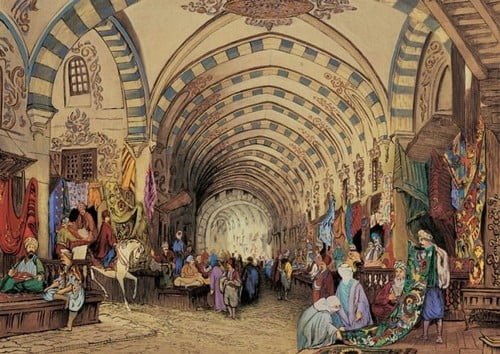If there is one thing everybody equally enjoys, it is shopping. In an age where online shopping is the preferred medium and seems convenient, we seem to have forgotten the joy of a traditional market. The marketplaces or bazaars are like a peep into the culture of a region. The vibrant colours, textures, and food items are all indicative of the socio-cultural and economic fabric of a place. Markets themselves have been of historical importance and have undergone regular changes. In India, markets have existed since ancient times but our focus is on the ancient bazaars of India.
The medieval city planning and architecture was strong point. The medieval cities were fortified structures with all essential components enclosed within its walls. Bazaars formed an intrinsic part of a city. They were usually located on the outside of the fort complex in a chowk or square plan. Delhi being an important city during the medieval period, has been a witness to the rule of several rulers and dynasties. The topic of our interest is the ancient bazaars of Delhi- Chandni Chowk and Meena Bazaar.
1. Chandni Chowk
Chandni Chowk is a market established at the time when the Mughal emperor Shah Jahan laid the foundation of his capital Shahjahanabad. This capital city was built in the medieval fortified style with walls, bastions, and gates at regular intervals. Although this medieval city has now undergone a great transformation, we still see some remnants of it that have retained their significance. One such place is Chandni Chowk, which to date is a bustling market.
Read more about: Delhi Markets
Chandni Chowk was built in 1650 AD as an accompaniment to the fort. It was planned by Shah Jahan’s favorite daughter Jahanara Begum. The market as the name suggests was built in a square plan (chowk) with a central pool that reflected the moonlight. This is how it came to be known as ‘Chandni Chowk or Moonlit Square’. Another story goes that the chowk was named after the silversmiths that were in abundance here and the name is derived from the word ‘Chandi’ (silver).
Planning of Chandni Chowk:
The bazaar was laid out from the Lahori Gate to the Fatehpuri Masjid. The bazaar stretched for more than a kilometre and had shops designed in the shape of a half-moon. Jahanara Begum undertook detailed planning of this space. A canal flowed through the market and at the centre, it broadened to form a pool. She also built a caravan serai (inn), a hammam (public bath), and char bagh gardens to add to the aesthetic beauty as well as the utility of the surrounding area.
The original bazaar was divided into 3 markets-
- Urdu Bazaar
- Johri Bazaar
- Fatehpuri Bazaar
The Mughal empire was known for its patronage to artisans and craftsmen. As the walled city of Shahjahanabad grew, several artisans and professionals from across India and other places came to provide services to the royal household. They grouped themselves according to their occupations in the various lanes of Chandni Chowk.
The lanes of Chandni Chowk have several hidden treasures within them. There are havelis and mosques built during different periods by various individuals and some of them have stood the test of time.
Patronage by Women:
In her article Women Patrons and the Making of Shahjahanabad, historian Swapna Liddle talks of how- ‘From the time of its inception in the mid–17th century, the physical and cultural fabric of Shahjahanabad has borne the stamp of women patrons.’
Besides Jahanara Begum who planned Chandni Chowk and its nearby areas, there were several women who contributed to the space within the walled city.
The mosques were a crucial component within the walled city and three of these were commissioned by the wives of Shahjahan and named after them Akbarabadi Masjid, Fatehpuri Masjid, and Sirhindi Masjid. It was a custom among the Mughals to refer to royal consorts by the place of their origin and hence they were called so.
The following periods also saw women patrons and they were not just royal ladies. There were women who were wives of nobles, generals, merchants, etc. who contributed to the architectural aspect of the city.
There are localities and havelis within Shahjahanabad named after women who owned these or played some part in its construction. Begum Samru ki Haveli is a major example amongst several others.
Decline during the British:
Chandni Chowk retained itself throughout the 18th century, despite repeated invasions and plunder. The Revolt of 1857 marked the decline of the Mughal Empire leading to several changes. Once the British gained control, they destroyed several structures in Chandni Chowk. They made various additions by constructing colonial-style buildings such as the Town Hall. This changed the face of the area.
Present Situation:
Although the grandeur of Chandni Chowk is lost now, its functionality remains intact. It is still a crowded marketplace that has changed over the course of time.
Today, Chandni Chowk has within its lanes several markets serving different purposes- Khari Baoli for spices, Katra Neel for clothes, Dariba Kalan for silver jewellery, Nai Sarak for books, Kinari bazaar for zardosi work, etc. It is also a paradise for foodies with delicious Mughlai outlets and sweet shops.
Read: Delhi market for shopping
2. Meena Bazaar
During the Mughal period, Meena Bazaar was a special bazaar, meant exclusively for women. It was also known as Khus Ruz (Day of Joy). The Meena bazaars took place during the 5 to 8 days of the Norouz or New Year festival. Emperor Humayun was the first Mughal Emperor to organize them. However, Akbar and his successors made it more elaborate.
Originally, the Meena Bazaar was closed to the general public and only the women of the harem, wives, and daughters of the nobles in the court, were allowed to set up their own stalls. They used to sell clothes, jewellery, handicrafts, etc. In those days, only the Emperor, princes, and some nobles were allowed to enter the bazaar. The sole purpose of these bazaars was to give the earnings to charity for social development. Today, the Meena Bazaars have become more elaborate, with everyone having access to it.
Also Read: India travel Tips
3. Chatta/Meena Bazaar:
Chatta Chowk or Meena Bazaar is located near the Red Fort. It is located behind the Lahori Gate, which leads to an arched passage.
In those days, this bazaar was called Bazaar-i-Musaqqaf, saqqaf meant a roof or Chatta Bazaar (a covered market). Bazaars at that time were usually open markets. A covered bazaar was a common thing in West Asia, but an innovation in India. It was built by Shah Jahan, as he was inspired by a similar marketplace that he had seen in Peshawar. This market was well-suited for the hot climate of Delhi.
During that period, it was meant to be an imperial bazaar catering to the needs of the royal family. It specialized in trading goods such as silk, brocades, velvet, gold, silverware, jewellery, gems and precious stones, etc.
The passage is lined with two-story flats that contain 32 arched bays serving as shops. The lower section consisted of two rooms- the front one was for the display of items and the one at the back for storage or business transactions. The upper section may have been used for official transactions. It has an octagonal court in the centre for sunlight and ventilation called Chattar Manzil.
Today, there are certain changes in this bazaar, as it is now open to all. The shops in the chowk sell souvenirs, eatables, drinks, etc., especially to tourists.
Conclusion:
Thus, it can be concluded that the once well-planned ancient bazaars of a medieval city have now been transformed. But, it still remains a vital part of the city’s past and present. They are a living example of a culture that changed gradually and has adapted itself to the present needs.
Read: grand hotel in New Delhi







